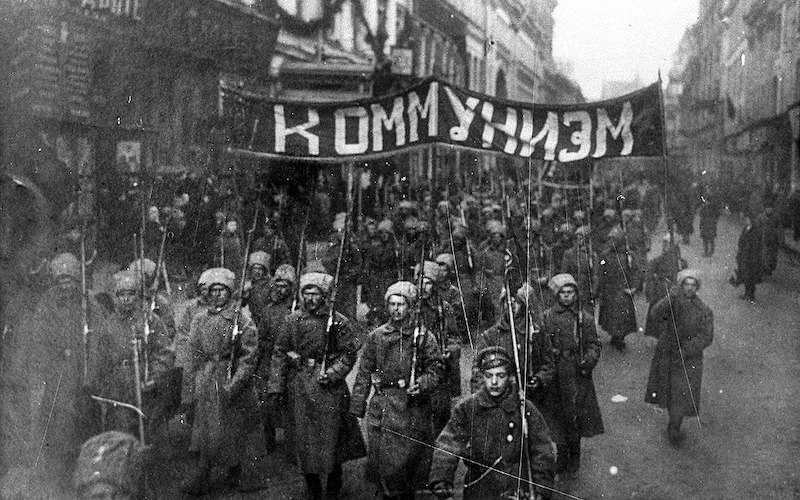Russian Revolution
Episode #4 of the course Revolutions that changed the world by James Wareing
From our previous lesson, we skip over a century before we reach today’s revolution, the Russian Revolution. It is perhaps the most memorable and potentially significant of the period, as it spawned the political ideology of Communism, which was to become one of the dominating ideas of the 20th century that led Russia toward a Cold War clash with the USA.
What Caused the Revolution?
Until 1917, Russia was ruled by tsars of the Romanov royal family, whose prosperity greatly contrasted the abject poverty of much of the rest of the country. Despite being a significant power in world politics, most of Russia was extremely poor, with a growing working class increased by industrialization.
In 1905, a trade union established by priest Georgy Gapon marched with factory workers in St. Petersburg, complaining about poor working conditions. Despite the peaceful nature of the protest, the Russian soldiers killed around 200 people in retaliation, starkly demonstrating the power divide between the imperial elite and the working class. Strikes fueled by the anger of the working class sparked strikes across Russia, leading Tsar Nicholas II to promise reform. Although social change did not materialize, the events of 1905 represented the growing significance and power of the Russian working class.
Main Events
Fast-forwarding to 1917, Russia was in the midst of World War One, during which it had suffered an unprecedented number of casualties and growing food shortages. Riots and a subsequent lack of control of the army led Nicholas II to abdicate. A liberal government was established, but as the war continued, social unrest at the quality of living conditions could not be quelled.
An alternative party was beginning to rise to prominence, the Bolshevik Party, led by Vladimir Lenin, who took power in the October Revolution. (The revolution actually took place in November, but at the time, Russia still used the Julian calendar, as opposed to the Gregorian one, which differed by 13 days.) During the October Revolution, the Bolsheviks overthrew the previous government and took power with a Communist agenda that proposed the government be ruled by councils of workers, inspired by Marxist ideas. It proposed a centralized and planned economy that abolished the potential for private property, with the aim that it would lead to the economic equality of its people. The Bolsheviks promised a program of “peace, land, and bread,” a popular message to a nation starving amidst a brutal war. Fittingly for this message, the coup was largely bloodless, and the Bolsheviks rose to power after gaining control of the government buildings.
What Happened Next?
While the revolution itself may have been largely bloodless, a civil war was soon to follow, from 1918-1920. The Bolsheviks had failed to gain effective control over all of Russia, leading many regions to declare independence or form resistance to the new Communist regime. The civil war pitted the Red Army of Lenin’s Communists against the White Army, which was not a cohesive unit but groups of dissidents. The differing ideologies that dominated this army made fighting against the united Bolsheviks challenging. In addition, the leadership of Leon Trotsky and the government promise of food for those who fought for the Red Army proved to be instrumental in swaying the war in the direction of the Bolsheviks.
The victory of the Red Army led to a Communist regime in Russia and the creation of the Union of Soviet Socialist Republics (USSR), which included modern-day Ukraine, Belarus, the Baltic nations, and the Caucasus. Communism, a nascent political system at the start of the revolution, quickly became a widespread and influential ideology, the antithesis of the capitalist system most significantly embodied by the USA. Its power peaked during the mid-20th century, when competition for global supremacy with the USA sparked the Cold War. Ultimately, Communism collapsed with the USSR following the dissolution of the Soviet Union in 1991. However, it still remains relevant and present around the world to this day.
How Is It Viewed Today?
November 7th used to commemorate the Revolution as a national holiday. However, the current president, Vladimir Putin, views the Revolution with less fondness. As an autocratic ruler, Putin is worried about any form of dissidence or potential for a modern-day revolution that may oust him. As a result, November 7th is no longer a national holiday. History can so rarely be swept under the rug, however, as much as Putin wishes it could be. If there are to be social and political changes in the near future, you can be sure that their influences will be drawn from the events of 1917.
Next lesson, we shall learn about the Spanish Revolution, which served as a precursor to World War II.
Recommended book
Guns, Germs, and Steel: The Fates of Human Societies by Jared Diamond Ph.D.
Share with friends

